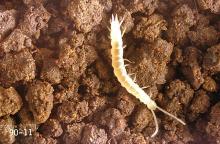Scutigerella immaculata
Pest description and crop damage Adult symphylans are about 0.12 to 0.33 inch in length, white, with prominent antennae 12 pairs of legs. Juveniles look similar to adults only with less legs and smaller body. Their bodies are creamy white. They resemble centipedes, but centipedes usually are larger, yellowish to brown, and when mature have more than 12 pair of legs.
Symphylans are general feeders that eat the fine root hairs and germinating seeds of many types of grasses and crop plants.
Scouting for pest pressure
Two primary sampling methods are used: baiting methods, and soil sampling methods. Each method has benefits and drawbacks, and the selection of a sampling method will vary depending on the objectives of the sampling (e.g., detection vs. precise population density estimation), time of year, and site conditions. Visit garden symphylan details to view how and when to employ each method.
Management-cultural control
Tillage reduces populations but usually not enough to achieve control where they are a problem. Crop rotation can be effective at suppressing symphylans. Crops grown in sandy soil have lower crop loss due to symphylan damage. Planting in higher densities can help reduce garden symphylan pressure per plant.
Management-chemical control
- azadirachtin/pyrethrins (Azera Pro, Azera and others) - Biological. See label rates as they vary for each product. REI 12 hr. PHI 0 days. Azadirachtin products have been evaluated in field trials in both preplant incorporation and carbon banding systems and shown efficacy for symphylan suppression at 15 days after treatment. Some products are OMRI listed for organic use.
See:



